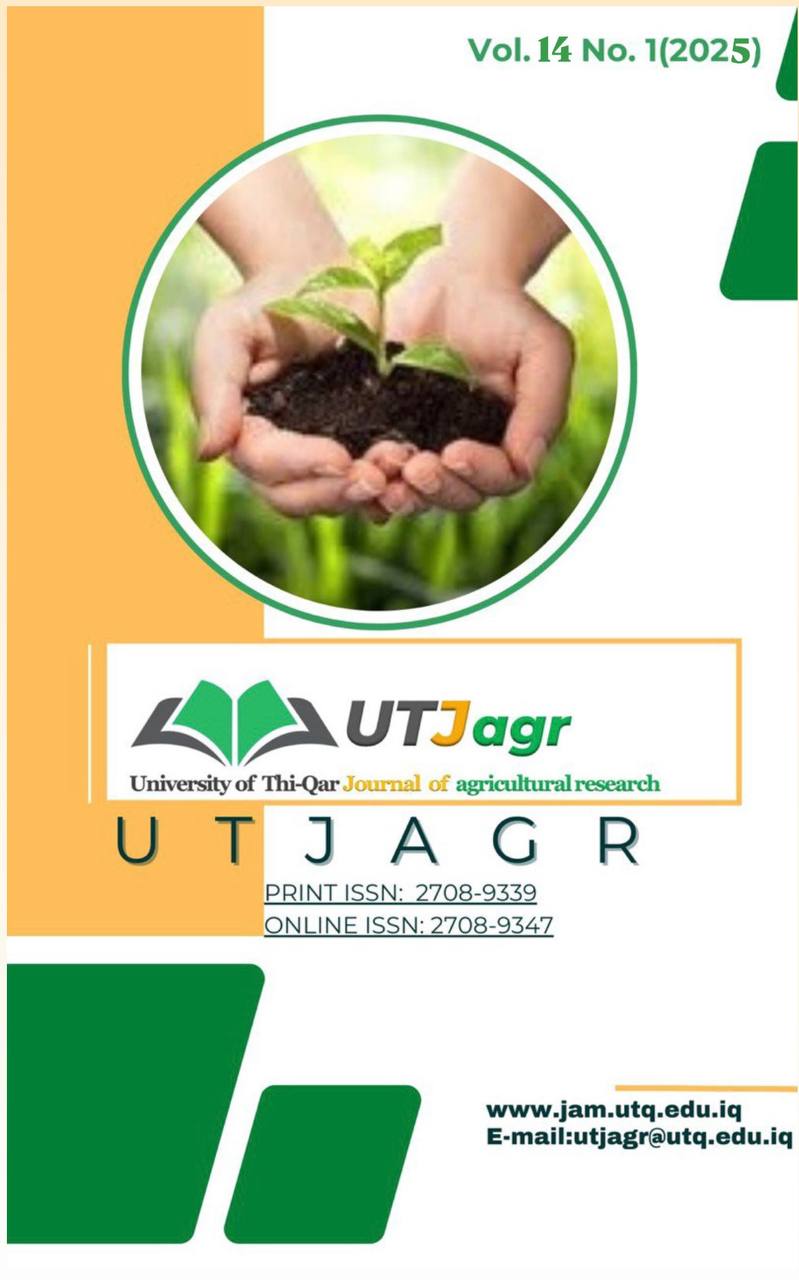Impact of Timed Artificial Insemination within Presynchronization Protocol on Reproductive Performance in Dairy Cows
DOI:
https://doi.org/10.54174/d5f9ne96Keywords:
Calving interval, Days Open, Pregnancy rate, Presynch, Timed Artificial InseminationAbstract
The aims of this study were to compare of some reproductive performance after timed artificial insemination (TAI) or using artificial insemination (AI) at oestrus detected. Fifty anoestrus cows, selected between 75 and 100 days postpartum, were separated into two equal groups. The control group (n = 25) consisted of cows that received no treatment and underwent artificial insemination when the first postpartum oestrus was identified. The treated group (n = 25) of cows underwent the presynchronization protocol [Day 0 (GnRH); Day 7 (GnRH); Day 14 (PGF2α); Day 15 (PGF2α); Day 16 (GnRH); TAI 16-24 hours latter]. Trans-rectal ultrasonography confirmed the pregnancy on days 35-40 after insemination. The results of this study show pregnancy rate (PR) for the treated group was significantly higher than (P=0.04) to that of the control group (56% vs. 28%, respectively). Furthermore, mean days of days open (DO) and calving interval (CI) for the treated group (104 ±2.8 and 384 ±2.8, respectively) were significantly (P=0.001) shorter than those in the control group 156 ±17.3 and 436 ±17.3, respectively). In conclusion, using TAI within presynchronization protocol eliminate the requirement for oestrus detection and improve reproductive performance at first service in postpartum dairy cows.
Downloads
References
Alsuwaidawi, A. and Alrawi, H.M. (2023) ‘Fertility of Postpartum Iraqi Cows Following Timed Artificial Insemination within Ovsynch or Presynch Protocols’, Al-Anbar Journal of Veterinary Sciences, 16(2), pp. 62–72. Available at: https://doi.org/10.37940/ajvs.2023.16.2.7.
Alsuwaidawi, A.I. and Alrawi, H.M. (2024) ‘Impact of three different ovulation synchronization protocols on first-service conception rates in postpartum cows’, Iraqi Journal of Veterinary Sciences, 38(3), pp. 647–652. Available at: https://doi.org/10.33899/ijvs.2023.143884.3265.
Bisinotto, R.S. et al. (2015) ‘Meta-analysis of progesterone supplementation during timed artificial insemination programs in dairy cows’, Journal of Dairy Science, 98(4), pp. 2472–2487.
Cakircali, R. et al. (2023) ‘Effects of daily propylene glycol drenching during the Ovsynch protocol on fertility and metabolic parameters in lactating dairy cows’, Reproduction in Domestic Animals, 58(8), pp. 1097–1103.
Cardoso Consentini, C.E., Wiltbank, M.C. and Sartori, R. (2021) ‘Factors that optimize reproductive efficiency in dairy herds with an emphasis on timed artificial insemination programs’, Animals, 11(2), p. 301.
Carvalho, P.D., Wiltbank, M.C. and Fricke, P.M. (2015) ‘Manipulation of progesterone to increase ovulatory response to the first GnRH treatment of an Ovsynch protocol in lactating dairy cows receiving first timed artificial insemination’, Journal of dairy science, 98(12), pp. 8800–8813.
Consentini, C.E.C. et al. (2022) ‘(TO BE SUBMITTED FOR JOURNAL OF DAIRY SCIENCE): FERTILITY PROGRAMS FOR LACTATING DAIRY COWS: A NOVEL PRESYNCH+ TIMED AI PROGRAM (DOUBLE E-SYNCH) PRODUCES SIMILAR OVARIAN DYNAMICS, SYNCHRONIZATION, AND FERTILITY AS DOUBLE-OVSYNCH’, “Luiz de Queiroz” College of Agriculture, p. 65.
Consentini, C.E.C. et al. (2025) ‘Reproductive outcomes of lactating dairy cows submitted to first timed artificial insemination protocols with different strategies to induce final ovulation’, Journal of Dairy Science, 108(1), pp. 1138–1149.
Cordoba, M.C. and Fricke, P.M. (2002) ‘Initiation of the breeding season in a grazing-based dairy by synchronization of ovulation’, Journal of Dairy science, 85(7), pp. 1752–1763.
Damiran, D. et al. (2018) ‘Effect of calving period on beef cow longevity and lifetime productivity in western Canada’, Translational Animal Science, 2(suppl_1), pp. S61–S65.
DeJarnette, J.M. and Marshall, C.E. (2003) ‘Effects of pre-synchronization using combinations PGF2α and (or) GnRH on pregnancy rates of Ovsynch-and Cosynch-treated lactating Holstein cows’, Animal reproduction science, 77(1–2), pp. 51–60.
Dinkissa, A.F. and Guye, M.E. (2022) ‘Review on Dairy Cattle Reproductive Performance Under Different Production System in Ethiopia’, American Journal of Food Science and Technology, 1(1), pp. 1–9. Available at: https://doi.org/10.54536/ajfst.v1i1.407.
Dixit, C.P. and Haloi, S. (2022) ‘Clinical application of ultrasound in bovine reproduction: A review’, Pharma Innov, 11, pp. 1311–1314.
Dobson, H. et al. (2007) ‘The high‐producing dairy cow and its reproductive performance’, Reproduction in domestic animals, 42, pp. 17–23.
Fricke, P.M. et al. (2014) ‘Reproductive performance of lactating dairy cows managed for first service using timed artificial insemination with or without detection of estrus using an activity-monitoring system’, Journal of Dairy Science, 97(5), pp. 2771–2781.
Fricke, P.M. and Wiltbank, M.C. (2022) ‘Symposium review: The implications of spontaneous versus synchronized ovulations on the reproductive performance of lactating dairy cows’, Journal of dairy science, 105(5), pp. 4679–4689.
Hafilah, I. and Solihati, N. (2024) ‘THE RELATIONSHIP BETWEEN PARITY TO PLACENTAL RETENTION AND THE IMPACT ON DAYS OPEN AND CALVING HUBUNGAN PARITAS DENGAN RETENSI PLASENTA DAN DAMPAK PADA DAYS OPEN ( MASA KOSONG ) DAN CALVING INTERVAL ( JARAK BERANAK ) PADA SAPI PERAH DI KPSBU LEMBANG’, 24(1), pp. 109–116. Available at: https://doi.org/10.24198/jit.v24i1.54679.
Holman, A. et al. (2011) ‘Comparison of oestrus detection methods in dairy cattle’, Veterinary Record, 169(2), p. 47.
Hubner, A.M. et al. (2020) ‘Effect of GnRH 7 days before presynchronization with simultaneous PGF2α and GnRH on reproductive outcomes in Holstein dairy cows’, Frontiers in Veterinary Science, 7, p. 574516.
Keister, Z.O. et al. (1999) ‘Pregnancy outcomes in two commercial dairy herds following hormonal scheduling programs’, Theriogenology, 51(8), pp. 1587–1596.
Kutlu, M. and Dinç, D.A. (2020) ‘Comparison of the effects of two pre-synchronization protocols (G6G and PG-3-G) on some reproductive performance parameters in Holstein cows.’, Eurasian Journal of Veterinary Sciences, 36(4).
Lakher, J.P. et al. (2019) ‘Efficacy of Ovsynch and Ovsynch Plus Protocol for Improvement of Fertility in Postpartum Sahiwal Cows.’, Indian Journal of Veterinary Sciences & Biotechnology, 14(4).
Lauber, M.R. and Fricke, P.M. (2024) ‘Effect of postpartum body condition score change on the pregnancy outcomes of lactating Jersey cows inseminated at first service with sexed Jersey or conventional beef semen after a synchronized estrus versus a synchronized ovulation’, Journal of Dairy Science, 107(4), pp. 2524–2542.
M’hamdi, N. et al. (2010) ‘Phenotypic and genetic parameters of reproductive traits in Tunisian Holstein cows’, Biotechnology in Animal Husbandry, 26(5–6), pp. 297–307.
Mariol, N.M. et al. (2024) ‘Impact of presynchronization and Ovsynch on early postpartum ovarian activity and fertility of dairy cows in Libya’, Open Veterinary Journal, 14(3), p. 822.
Martins, J.P.N. et al. (2017) ‘The effect of presynchronization with prostaglandin F2α and gonadotropin-releasing hormone simultaneously, 7 d before Ovsynch, compared with Presynch-10/Ovsynch on luteal function and first-service pregnancies per artificial insemination’, Journal of Dairy Science, 100(6), pp. 5107–5116.
Moreira, F. et al. (2001) ‘Effects of presynchronization and bovine somatotropin on pregnancy rates to a timed artificial insemination protocol in lactating dairy cows’, Journal of dairy science, 84(7), pp. 1646–1659.
NM, B. (2006) ‘Optimizing ovulation to first GnRH improved outcomes to each hormonal injection of ovsynch in lactating dairy cows’, J Dairy Sci, 89, pp. 3413–3424.
Oosthuizen, N. et al. (2025) ‘Comparison of different GnRH compounds on fertility outcomes in ovulation synchronized and presynchronized beef cows’, Frontiers in Animal Science, 6, p. 1502984.
Pursley, J.R. et al. (1997) ‘Pregnancy rates per artificial insemination for cows and heifers inseminated at a synchronized ovulation or synchronized estrus’, Journal of dairy science, 80(2), pp. 295–300.
Pursley, J.R. and Martins, J.P.N. (2011) ‘Impact of circulating concentrations of progesterone and antral age of the ovulatory follicle on fertility of high-producing lactating dairy cows’, Reproduction, Fertility and Development, 24(1), pp. 267–271.
Pursley, J.R., Mee, M.O. and Wiltbank, M.C. (1995) ‘Synchronization of ovulation in dairy cows using PGF2α and GnRH’, Theriogenology, 44(7), pp. 915–923.
Rabiee, A.R., Lean, I.J. and Stevenson, M.A. (2005) ‘Efficacy of Ovsynch program on reproductive performance in dairy cattle: A meta-analysis’, Journal of dairy science, 88(8), pp. 2754–2770.
Reith, S. and Hoy, S. (2018) ‘Behavioral signs of estrus and the potential of fully automated systems for detection of estrus in dairy cattle’, Animal, 12(2), pp. 398–407.
SARI, A., AYAŞ, R. and SELVİ, M.H. (2025) ‘Evaluation of Fertility Parameters and Nutrition-Fertility Relationship in Dairy Cattle Farms in Ereğli District of Konya Province’, Evaluation, 2(1).
Sari, E.C., Hartono, M. and Suharyati, S. (2017) ‘Faktor-faktor yang memengaruhi service per conception sapi perah pada peternakan rakyat di Provinsi Lampung’, Jurnal Ilmiah Peternakan Terpadu, 4(4).
Senbeta, E.K., Abebe, A.S. and Gibe, A.W. (2024) ‘Effect of parity on service per conception, gestation length, milk yield, calving interval, and calf birth weight of crossbred dairy cows.’, Archives of Veterinary Science, 29(2).
SM, J. (2000) ‘Evaluation of reproductive performance in lactating dairy cows with prostaglandin PGF_< 2α>, gonadotropin-releasing hormone, and timed artificial insemination’, J Dairy Sci, 83, pp. 2366–2372.
Somers, J.R. et al. (2015) ‘The effect of lameness before and during the breeding season on fertility in 10 pasture-based Irish dairy herds’, Irish Veterinary Journal, 68, pp. 1–7.
Souza, A.H. et al. (2008) ‘A new presynchronization system (Double-Ovsynch) increases fertility at first postpartum timed AI in lactating dairy cows’, Theriogenology, 70(2), pp. 208–215.
Stevenson, J.S. (2016) ‘Physiological predictors of ovulation and pregnancy risk in a fixed-time artificial insemination program’, Journal of Dairy Science, 99(12), pp. 10077–10092.
Stevenson, J.S. and Britt, J.H. (2017) ‘A 100-Year Review: Practical female reproductive management’, Journal of dairy science, 100(12), pp. 10292–10313.
Strickland, J.M. et al. (2024) ‘When Implementing the Presynch-11/Ovsynch Reproductive Management Program, the Fertility of Lactating Dairy Cows Improved When They Received Timed Artificial Insemination Compared with the Inclusion of Estrus Detection’, Animals, 14(15), p. 2235.
Temesgen, M.Y. et al. (2022) ‘Factors affecting calving to conception interval (days open) in dairy cows located at Dessie and Kombolcha towns, Ethiopia’, PloS one, 17(2), p. e0264029.
Widodo, O.S. et al. (2022) ‘Relationship between ovary size and anti-müllerian hormone levels in Holstein–Friesian cows’, Frontiers in Veterinary Science, 9, p. 828123.
Wiltbank, M.C. and Pursley, J.R. (2014) ‘The cow as an induced ovulator: Timed AI after synchronization of ovulation’, Theriogenology, 81(1), pp. 170–185.
Yılmaz, H. and Sarıözkan, S. (2020) ‘Kayseri ili Yahyalı ilçesi süt sığırcılık işletmelerinde suni tohumlama uygulamaları ve başarıyı etkileyen faktörler’, Erciyes Üniversitesi Veteriner Fakültesi Dergisi, 17(2), pp. 95–102.
Yousuf, M.R. et al. (2016) ‘Presynchronization of lactating dairy cows with PGF2α and GnRH simultaneously, 7 days before Ovsynch have similar outcomes compared to G6G’, Theriogenology, 86(6), pp. 1607–1614.

Downloads
Published
Issue
Section
License
Copyright (c) 2025 mahmood alqaisi, Ismaeel Saad Kuridi , Omar Jassim Alhayany , Ahmed Ibrahem Alsuwaidawi

This work is licensed under a Creative Commons Attribution-NonCommercial-ShareAlike 4.0 International License.







1.png)

